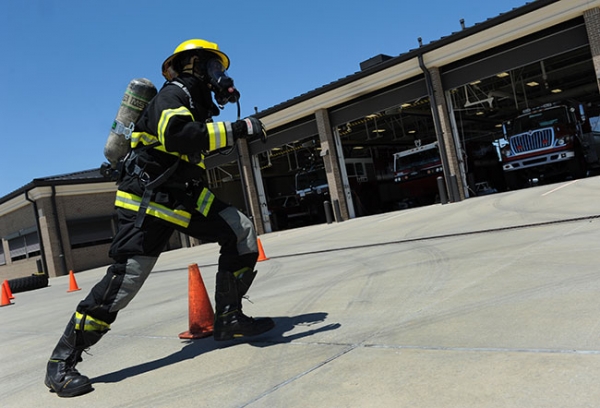
Fit for duty: April 2019
By Sherry Dean
Features Fitness Health and WellnessAs we age and life priorities take different directions with jobs and families, previously active lifestyles can also change.

Maybe you have never needed to officially work out because you were already active in a sport that kept you strong and your cardio challenged. If your ability to maintain that activity has been reduced, a physical job like fire fighting requires you to find a way to keep fit and manage a limited timeframe.
Making time for your workout is critical, but it doesn’t mean two hours a day in the gym. If you are venturing into working out for the first time or it has been a long time, how you start will help with your success. If you have a medical condition, consulting a physician is always recommended. Please consider the physical requirements of your actions as a firefighter. If you need a physician’s okay to work out, you need a physician’s okay to fight fires.
Be realistic about your current fitness level. If you don’t run, don’t expect to head out to do a 10-kilometre jog the first time. Discover your current fitness levels and set them as a benchmark. Time a five-kilometre jog/run, take your body measurements, mark your best pushups/situps etc.
Set goals and measure them occasionally. Setting a standard to lose 20 pounds or increase a squat by 50 pounds may both be entirely attainable, but cutting the goals down into manageable pieces is better.
Ensure your goals meet the needs of your work. Be practical about what you need to work on. If you are strong, but don’t have good cardio, don’t avoid it. Goals should be moveable targets and may switch between cardio, strength, endurance or mobility or involve all aspects.
Design your workout. If working out is new to you, it may be difficult to know how or where to start. It isn’t necessary to hire a personal trainer. Online resources are more than plentiful and friends and colleagues can be great resources.
Personal trainers can be great. It may be just what you need. Trainers should provide you leadership and direction to be able to work out without needing a chaperon. If you are learning new exercises and form they can be invaluable to help you get on the right track.
Progress realistically. Try not to overdo a new regime. It can make for burnout and injury. Slower, steady progress is a good approach. New workouts often bring quick results, but they may be followed by plateaus. Plateaus are great indications for changing it up. You shouldn’t work out the same way every day. Variety allows your body to better recover from the stressors of exercise and muscles to repair.
Listen to your body. It isn’t necessary to push yourself to the point of complete exhaustion or nausea. Feeling lightheaded and nauseous is not uncommon if you are new to working out. Your body is telling you the workload is exceeding its ability to balance oxygen and blood flow demand.
Gradually increase the demand. There are a number of changes you can make to a simple workout to help move you forward in progress. These are just a few options.
- increase the number of different exercises
- increase the intensity of your effort – more weight, faster
- increase the work period time – three rounds instead of two
- decrease the recovery time between exercises
If you find you are losing interest or motivation, change something up. Maintaining your fitness is an imperative part of your responsibility to your crew and your family.
Following is a 20-minute, non-stop workout, but modify it to suit your fitness level. Use the adaptations provided as you need.
Warm-up x 2
- 20 walking lunges
- 10 scapular push ups (Arms do not bend, shoulders do all the work.)
- 10 wall slides (Body, hands and elbows close to wall. Hands travel from shoulder height to overhead and back – slowly.)
- 10-inch worms (Bend at hips, pike position. Use arms walk out as far as they can to fully extend and lower the body to the ground. Keeping your legs straight use your feet to walk towards your hands into pike position. Repeat)
Workout – 10 to 20 minutes with as few breaks as possible
- Five pullups (Body weight inverted rows using an angle that challenges you to complete five reps.)
- 10 pushups (Inclined push ups, wall push ups, knee push ups.)
- 15 air squats (Modify height as needed, but try to get to parallel. To increase intensity try jump squats.)
- 20 sit ups (Decrease the number if needed. To increase intensity, try V-ups or toes to bar)
- Cool Down
- Five arm circles each direction both arms
- Quad stretch 30 sec to one minute
- Lat stretch 30 sec to one minute
- Five cat/cow
Have fun. Work Hard. Stay safe.
Sherry Dean is a career firefighter/engineer with Halifax Regional Fire & Emergency Service. She has more than 20 years of experience in fitness and training. Contact Sherry at deansherry@bellaliant.net.
Print this page